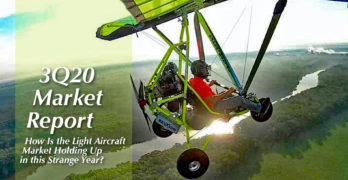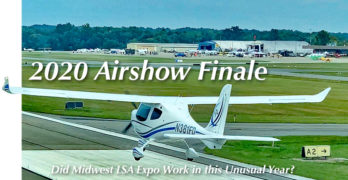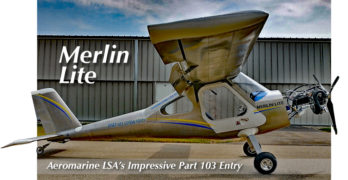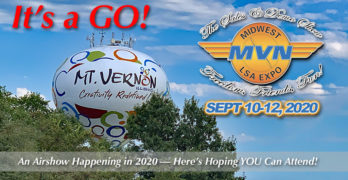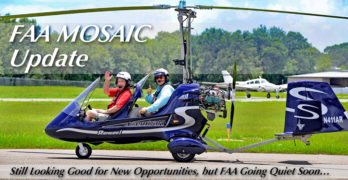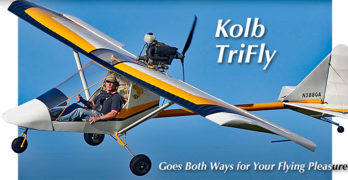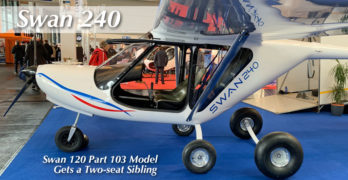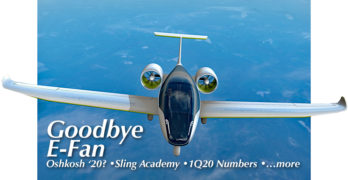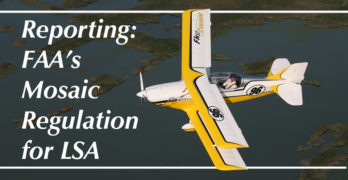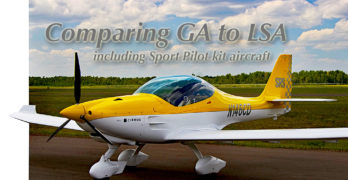By any measure 2020 has been an unusual year. While millions were thrown out of work by lockdowns to prevent the virus from spreading, we all read or hear that plenty of other workers can work from home or have businesses that cannot be restricted by government decrees.
In this context, how might the aviation industry be holding up? We read — and some brave travelers have experienced first-hand — how the airline industry is in a deep hole, prompting large layoffs.
In this third quarter report for the calendar year, I’ll look at some numbers for general aviation manufacturers as well as the light aviation industry that has my full focus.
The short answer: some are doing surprisingly well.
Light-Sport Aircraft
Before I launch into an analysis, I must extend grateful thanks to Datastician Extraordinaire, Steve Beste, who does such a comprehensive job compiling and demystifying data from FAA’s aircraft registration database.
Search Results for : powered parachute
Not finding exactly what you expected? Try our advanced search option.
Select a manufacturer to go straight to all our content about that manufacturer.
Select an aircraft model to go straight to all our content about that model.
Did It Work? Midwest Light-Sport Expo 2020 — the Year’s Final Airshow
Lots of doubters expressed their opinions in the weeks and days before Mt. Vernon’s 12th running of this sector-specific event. Did it work? Were the naysayers right or wrong?
I will express one person’s opinion but reflect a number of comments I heard: “Thank goodness for Mt. Vernon airport manager Chris Collins and his contingent of orange-shirted volunteers who hosted this event,” making it another success.
To me, “success” means no accidents (none happened) and a decent turn-out that got pilots in new aircraft and vendors the sales that sustain them (both happened).
Summarizing Midwest 2020
In a typical year, Midwest attracts 1,500 or more pilots for the three days of event. My casual estimate is that 2020 was at least as strong as before and perhaps it was even up a bit. No one knows more. Midwest does not charge a fee to enter and more than one entry gate would make any effort to count heads futile.
Merlin Lite… New, All-Metal, Fully-Enclosed, “Deluxe” Part 103 Ultralight
Are you looking for an affordably-priced airplane? On this website, you can find many choices of aircraft that qualify, with something to fit the budget of almost any pilot.
Using the Search bar at the top of the page, you can look for any text anywhere on this website. Have you tried it? More on this below…*
In this article, let me introduce a new aircraft to you …and, no, this is not Merlin PSA.
Merlin Lite Delight
Among affordable aircraft, Part 103 ultralights have a solid position, both as fixed wing aircraft or alternatives like weight shift, powered parachutes, and gyroplanes.
However, such “alternative aircraft” may not be what you had in mind. Many are open cockpit and pilots trained in a Cessna or Piper can feel uneasy being out in the open (even if behind a pod and windscreen). Also, weight shift trikes, powered parachutes, or gyroplanes handle differently from stick (or yoke) and rudder.
It’s ON!!! — Midwest Light-Sport Aircraft Expo WILL Open September 10th
Many years ago — back in February 2020 — I attended my last airshow. Fortunately, that was not the dark ending to a most trying year.
For 2020, the next airshow is Mt. Vernon Airport’s (KMVN) Midwest LSA Expo — slated for September 10-11-12, 2020. Hurray!
I don’t know about you (certainly not everyone, I am aware) but I am raring to go. Airshows dictate my annual calendar so this virus-infested year has done a job on my collection of great airplane info to present to you. Fortunately, I have found plenty of other newsworthy materials, but, man!, am I happy to go to Mt. Vernon this year.
Those considering attending MWLSA but who are concerned about exposure to the virus can check out their Covid-19 preparations.
GO, Mt. Vernon!
“We believe we have good plans in place to keep everyone safe while meeting the mandates set out by various organizations,” said affable and energetic airport manager, Chris Collins.
FAA’s New Light-Sport Aircraft Regulation — Progress Update for July 2020
The end is near! Or, is it?
The reference is to the long-running effort to revise the FAA regulation affecting Light-Sport Aircraft. The new ruleset has been discussed back into 2017 and started to take shape in early 2019. Almost two years later, what is the status?
I have reported on this earlier: May 2019 • July 2019 • January 2020 • and April 2020. For additional detail, go back and check those articles. In this newest report — based on LAMA‘s work with the aviation regulator — I will describe the newest development although a short review of the history is useful.
When I ask if the end is near, I mean to ponder if FAA is done with their work. Even some in industry believe FAA is about to release what’s call an NPRM: Notice of Proposed Rule Making.
Try and Fly TriFly — Kolb’s Wonderful Single Seat Light Aircraft Goes Both Ways
Some pilots are wary of taildraggers. This is hardly surprising since only tricycle-gear aircraft have been used in primary flight instruction dating back into the 1970s. Most pilot have no experience with taildraggers but nearly all have heard of the dreaded ground-loop tendency such gear configuration can allow.
Indeed, when investigating insurance for a taildragger, you will have to prove you have some experience or get training from a suitably-experienced instructor — and you won’t find many able to help you.
How about if an aircraft went both ways? What if an affordable aircraft allowed you to fly with tricycle gear but permitted you to practice your taildragger technique yet still use the nosewheel’s self-straightening capability if you start to get a little “sideways” (literally or figuratively)?
Kolb Aircraft has an answer.
Kolb TriFly
Producers of Part 103 aircraft, such as Kolb Aircraft report consistently strong business for the last few years.
Swan Producer Adds Two-Seat Version to Popular 103-Compliant Ultralight Aircraft
We live in an age of sophisticated two seaters, a large flock of wonderful aircraft of every description. Such two-place flying machines lead in sales and perhaps that’s to be expected. Around 80% of light aircraft buyers prefer three-axis fixed-wing aircraft. This is hardly surprising as that’s what nearly all pilots have used for primary training since the ’70s.
To select another aircraft type means going out on a tree limb. This is especially true with what I call “alternative aircraft” — weight shift trikes, powered parachutes, motorgliders, and gyroplanes. It would include lighter-than-air, too, if we had more than a single entry.
However, some three-axis fixed wingers also disregard Part 103-compliant aircraft. Some say, “Those things are flying lawn chairs,” by which they try to disparage the category hinting they’re too “flimsy.” Most who say this probably never sat in one let alone flew one.
One entry I’ve written about (see my earlier report) appears to have be viewed differently, perhaps as it has a full enclosure and is built of composite materials.
Light-Sport Aircraft News: Oshkosh? E-Fan Ends! 1Q20 Numbers, Sling Academy, Refreshed EMS
In the rush of coverage of Vintage Ultralights and other late-breaking stories such as the Blackwing speed record, I had to set aside a few news items. Here’s a catch-up…
I am pleased to serve a need for news during a month when we should have been covering Sun ‘n Fun and Aero Friedrichshafen. As everyone knows, those events are now rescheduled for 2021, both as a result of the global lockdown that has affected hundreds of other events.
You hardly need any more coverage of the coronavirus craziness so let’s get to aviation news and take a small break from these worldwide events. But first…
Oshkosh — Go or No/Go?
It has become one of the most-asked question in aviation. Will the big summer celebration of flight happen or go the way of every other airshow this year?
FAA’s Proposed Regulation (MOSAIC) — LAMA’s Spring 2020 Update Report
In recent months many light aviation enthusiasts have been asking about progress on FAA’s proposed rewrite of the Light-Sport Aircraft regulations. Following a lengthy teleconference in 2019, the Light Aircraft Manufacturers Association is pleased to provide a further update for the agency’s work on MOSAIC, or Modernization of Special Airworthiness Certification. Here is our earlier article on this subject.
This update is one of a continuing series. As time passes and FAA progresses toward its goal — of issuing a NPRM, Notice of Proposed Rule Making — LAMA requests a teleconference or in-person visit to learn the rule writers’ latest concepts and language decisions.
This progress reports identifies new discoveries and clarifies previous statements that may now be better understood.
Some Key Messages
FAA is moving forward on the rulemaking project yet everything remains in progress while the agency gathers internal assessments. What follows is as accurate as possible at this time but changes will occur.
Special and Experimental Light-Sport & Sport Pilot Kits Compared to General Aviation
If you like airplane statistics and facts, this article may interest you. Some pilots don’t follow such things while others eat it up (you know who you are). For these readers, we have a new perspective that many may find intriguing.
The comparisons below relate to the numbers of Single Engine Piston (SEP) general aviation (GA) aircraft on the U.S. registry compared to an umbrella group including SLSA, ELSA, and kit-built aircraft that Sport Pilots may fly (or those using a different certificate but exercising the privileges of Sport Pilot) …in other words, all the aircraft we cover on this website.
Even after more than 15 years of LSA and the kits that Sport Pilots can fly, the GA fleet still seems immeasurably larger. The truth is, we can measure it; in fact, we have up-to-date info and both are as accurate as FAA’s database allows.
Which Is Bigger?
The total SEP GA fleet numbers approximately 135,000 aircraft, 15 times larger than LSA/SP kits (by our criteria, about 9,000 aircraft) but the bigger number includes aircraft made since the 1940s and significantly in the ’60s and ’70s.
- « Previous Page
- 1
- …
- 4
- 5
- 6
- 7
- 8
- …
- 45
- Next Page »


